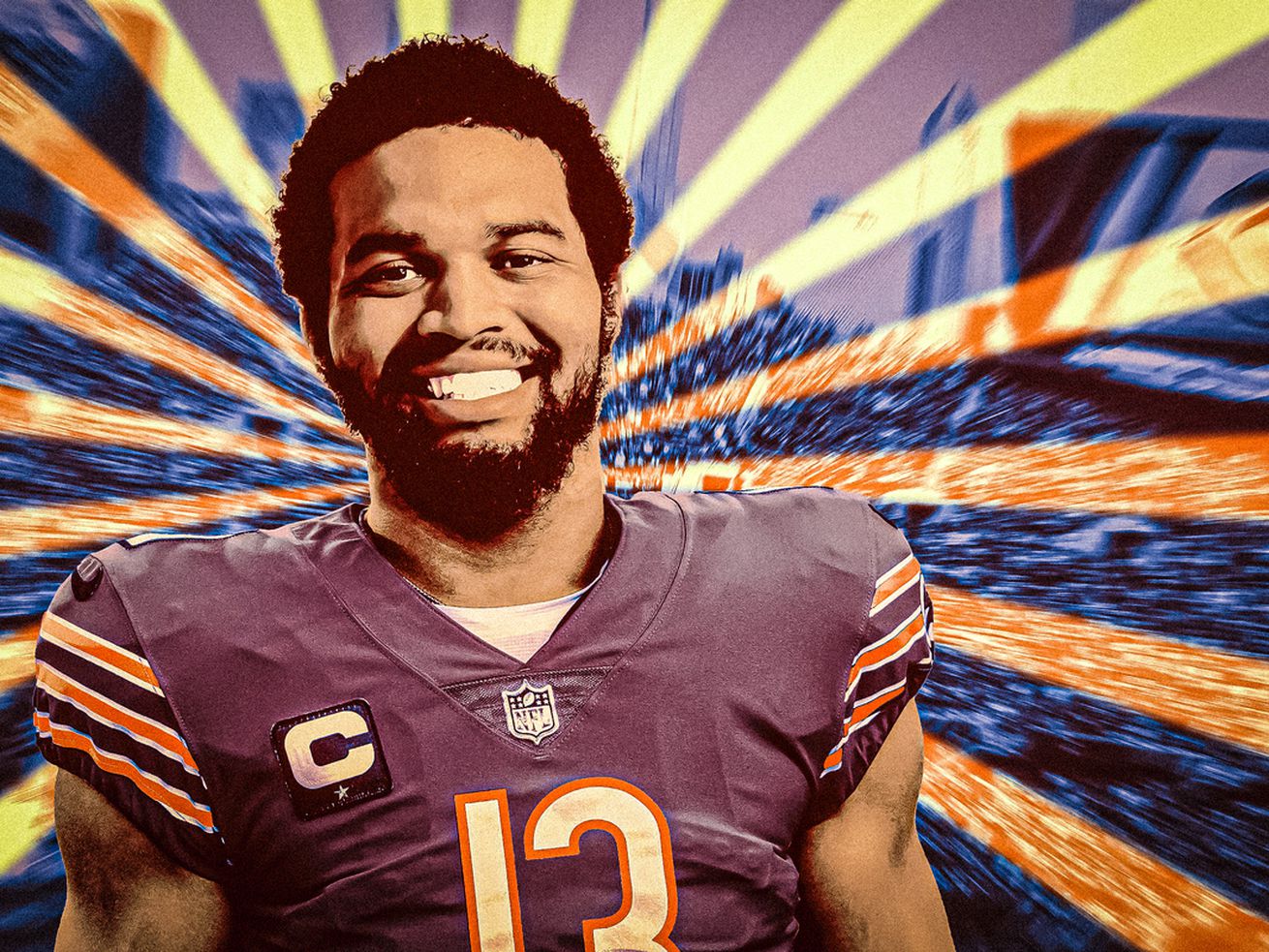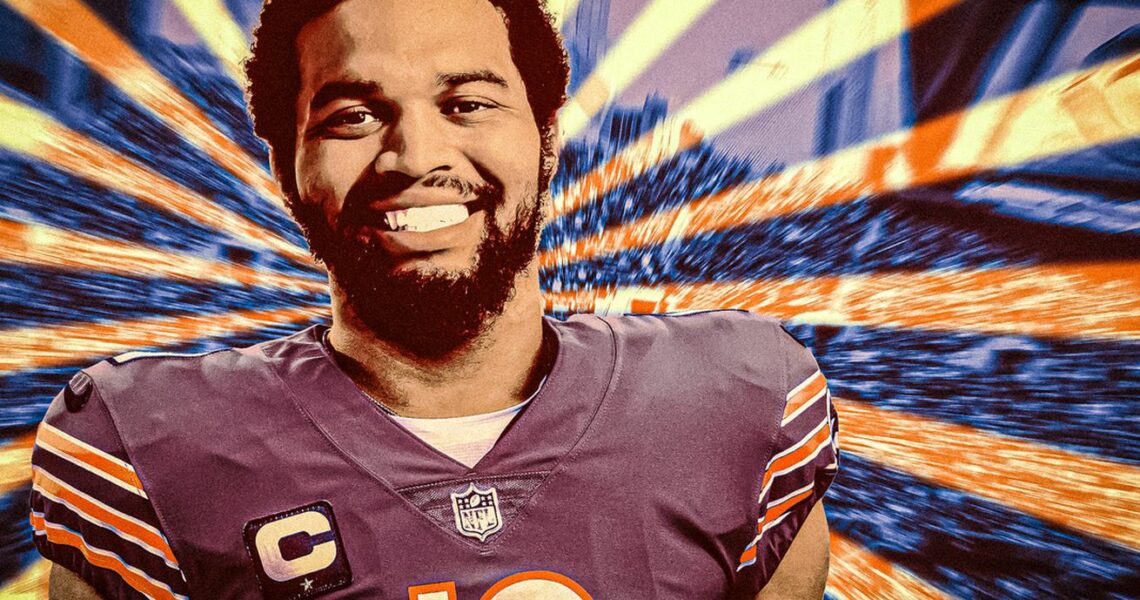
Chicago has been called a franchise where quarterbacks “go to die.” But after selecting Williams, the Bears may finally have the player—and the infrastructure around him—to change that.
A couple of weeks before the Bears drafted Justin Fields in 2021, Jim McMahon, probably the best quarterback in franchise history, said, “Chicago is where quarterbacks go to die.”
Probably not the words Fields hoped to hear upon his entry into the NFL. But that’s now a belief that Caleb Williams, the Heisman-winning quarterback out of USC, will be trying to change after being selected by the Bears with the first pick in the 2024 NFL draft. Williams’s mission is simple: to be the best Bears quarterback of all time. That’s not as tall of a task as it sounds.
The Bears have never had a great quarterback. Jay Cutler finished .500 as the Chicago starter. Jim Harbaugh was better on the Colts than he was on the Bears. McMahon won a Super Bowl, but he was a game manager who relied on the vaunted ’85 defense to steamroll everyone in their path. McMahon only truly cemented his legacy as the Bears’ GOAT when he won another Super Bowl as a backup quarterback for the Packers—and wore a Bears jersey to the White House.
Now Williams is about to be in the bizarre position of being seen as the most talented quarterback in team history … from the moment he steps on the field. In an ironic twist of fate, Williams ascended to his no. 1 pick status by modeling his career after one player: Aaron Rodgers, the biggest Bears nemesis in recent history. To help Chicago get past its quarterback-induced demons, Williams will have to play like the team’s former owner—and find a similar level of success.
Fortunately for him, the Bears are finally in a place to support a quarterback of the future.
The Bears invented the modern quarterback position. In the 1940 NFL title game, they moved Sid Luckman into the “T formation,” and Chicago beat Washington 73-0. The move changed football history. But Luckman retired almost 75 years ago, and ever since, the Bears have been looking for a star under center.
Chicago has never had a quarterback who’s thrown 30 touchdown passes in a season. It has never had a quarterback who’s thrown for 4,000 yards in a season. Every other NFL team has had a quarterback hit both of those marks—and it’s worth noting that the Bears are tied for the NFL’s oldest team, having been founded in 1920. The only Bears quarterback to make the Pro Bowl since McMahon is Mitchell Trubisky. And Trubisky was only invited as an alternate when the quarterback ahead of him made the Super Bowl.
“You think about all the first-round draft pick quarterbacks they’ve had since [1995],” Erik Kramer, a former undrafted free agent who set the Bears record for both single-season passing touchdowns (29) and passing yards (3,838), told ESPN. “It’s not such a lofty [passing yards] mark that it shouldn’t have been broken many, many times, especially with the passing game today and the way they’ve legislated defense out of the game. It really doesn’t make sense to me.”
Perhaps you’re thinking the Bears haven’t prioritized finding a quarterback. Quite the opposite. According to ESPN, Chicago used 10 first-round picks on quarterbacks between 1967 and 2022, more than any other team in the NFL in that span. Quite literally, no other team has invested more into the position—and no other team has gotten less out of it.
Chicago was hoping Fields would end that misery when it traded up to select him with the no. 11 pick in 2021. But the Bears threw him to the wolves as a rookie, giving him his first career start against an always-tough Browns defense. Chicago lost the game 26-6. The Browns sacked Fields nine times; they outgained the Bears 418 yards to 47; and Chicago finished with one net passing yard.
Things got more promising in Fields’s second year, as he became the third quarterback to ever rush for 1,000 yards in a single season, after Michael Vick and Lamar Jackson. But Fields also took a league-leading 55 sacks and struggled to process the offense.
And yet it is easy to argue that the Bears broke Fields. They took a dynamic rushing threat and tried to shoehorn him into a static dropback passing offense that didn’t have much receiving help. Fields’s top wideouts in 2022 were Darnell Mooney, Dante Pettis, Equanimeous St. Brown, Byron Pringle, and the recently-exiled-from-Pittsburgh Chase Claypool. Coming into 2023, Fields had never had a 300-yard passing game in his career. It looked like that might change, with the addition of legit no. 1 receiver D.J. Moore, who came over in a March 2023 trade with the Panthers. But with Chicago having the no. 1 pick in this year’s draft, and with Williams on deck, it was too late. The Bears traded Fields to Pittsburgh for a conditional fourth-round pick.
Now, the Bears are in a very different position than they were when they selected Fields. Moore had the best season of his career last year by receiving yardage (1,364) and touchdowns (eight). Ditto for incoming wideout Keenan Allen, who set career highs in catches (108) and yards per game (95.6) for the Chargers in 2023. Add in tight end Cole Kmet and running back D’Andre Swift, and this is one of the best skill groups Chicago has had in years.
Plus, Chicago’s defense was legit last year after adding defensive end Montez Sweat at the trade deadline. From Week 12 on, the Bears were the third-best defense in expected points added per play and nobody scored more than 20 points against them. They shelled out to re-sign Sweat and cornerback Jaylon Johnson, ensuring the core of head coach Matt Eberflus’s defense returns this year, and this could be a monstrous defense once again. Arter Fields failed due to a lack of infrastructure, the Bears have built Williams a team as big and bold as their new stadium proposal.
Half of my brain that loves a good rendering – “wow this is sick”
The other half that lives in reality – “where the fuck are we going to park?” pic.twitter.com/BlPF2nnOqO
— Big Cat (@BarstoolBigCat) April 24, 2024
Now it’ll be up to him to unlock this roster—and keep the team afloat in a division that’s only getting better.
“I have owned you all my fucking life,” Aaron Rodgers screamed at the Chicago crowd. “I’ve owned you; I still own you! I still own you.”
It was October 2021, and Rodgers had just run in a touchdown to put Green Bay up 10 and secure yet another Packers win against Chicago. His scream immediately went viral. He was soon listed on Wikipedia as the Bears’ owner—and rightfully so. Rodgers is 24-5 lifetime against Chicago with an absurd ratio of 64 touchdown passes to 10 interceptions. He is the biggest villain in modern Bears history. And Williams is absolutely obsessed with him.
“My team was Green Bay when Aaron Rodgers was there,” Williams said on The Pivot podcast earlier this month. “Because of Aaron, I’m a player guy. I couldn’t join the bandwagon of becoming a Jets fan. I couldn’t do it. So I’m still an Aaron Rodgers fan. If he’s playing for somebody, I am going to root for him.”
At the combine this year, Williams was asked whether teams had any concerns about his height or his weight. He brushed it off. “I’m around Aaron Rodgers size and maybe weight too: 215, 220 and 6-1, 6-2.” That same week, Williams said, “I try to model my game after a bunch of guys, but Aaron Rodgers I would say is no. 1.”
Plenty of analysts have made comparisons between Williams and Rodgers or Patrick Mahomes this offseason. And any time a prospect, even a legendary one like Williams, is compared to a future Hall of Famer, it should make you pause. But the more you watch his film, the more the similarities come through.
Williams has excellent pocket management and can win with quick throws and a high football IQ. But he also has Rodgers’s penchant for magic: long, winding scrambles that end in pinpoint throws on the run. A Twitter user overlaid a Williams play against Nevada with a Rodgers play against the Vikings, and, well, just take a look:
caleb williams is aaron rodgers 2.0 pic.twitter.com/I12uzjaywQ
— weirdborne (@weirdborne) March 17, 2024
Like Rodgers, Williams can show technically flawless footwork on one delivery, and weird footwork on others—whether it’s throwing while driving backward or even sideways—that somehow still results in a perfect pass.
Aaron Rodgers ….Caleb Williams ..2 floating arm quarterbacks feet dont need to be set to get some serious velocity on the rock …just stuff you can’t teach pic.twitter.com/hWSSxrAcMA
— Detective Holmes (@Stopthemisinfo) February 28, 2024
I’m sure this has been said plenty, but I see a lot of Aaron Rodgers in Caleb Williams’ game.
He’s so calm and fluid in the pocket that he makes everything look nonchalant. Makes some incredible off-platform throws and works various angles on his release point. pic.twitter.com/WUmsMFTohn
— Alfredo Brown (@ThePretendGM) March 20, 2024
Williams has Rodgers’s habit of occasionally shrugging off easy checkdowns to try to find a big play. He has Rodgers’s ridiculous touchdown-to-interception ratio: Williams threw for 30 touchdowns and five interceptions in college last year, and 42 touchdowns and five picks in his Heisman-winning 2022 season.
And, of course, he has the Hail Marys. Rodgers completed three Hail Mary passes in 13 months from 2016 to 2017. Here’s Caleb in high school, throwing a Hail Mary to win the conference championship … on his birthday … with a broken foot.
Idk how I never knew this till now but Caleb Williams once won a state championship on a walk off Hail Mary
Craziest part was that they were down 20 points earlier, and he had to convert a 3rd and 33 on the drive before.
Caleb also had a receiving touchdown, on top of 358… pic.twitter.com/w1tp6aglf8
— DaWindyCity Productions (@dwcprodz) March 26, 2024
All those Rodgers similarities won’t make winning the NFC North any easier, though. Per FanDuel’s betting odds, the Bears are expected to finish in third place in the division, behind the Packers—who have once again transitioned to a new franchise quarterback in Jordan Love and look poised to take yet another step forward in 2024—and the Lions, who nearly made the Super Bowl last season and have a young core the features receiver Amon-Ra St. Brown and steamroller left tackle Penei Sewell. The Vikings, meanwhile, are a season removed from a 13-win campaign and have receiver Justin Jefferson in his prime, second-year receiver Jordan Addison, and tight end T.J. Hockenson. Considering the youth on all of these teams, the NFC North is a smart bet to be one of the most competitive divisions in the NFL for the next five years.
For the Bears to be in the mix, they’ll need their new quarterback to step up. And Williams is out to prove that Chicago is a place quarterbacks can not only survive, but thrive. Time to let Aaron Rodgers know that the Bears are under new ownership.

